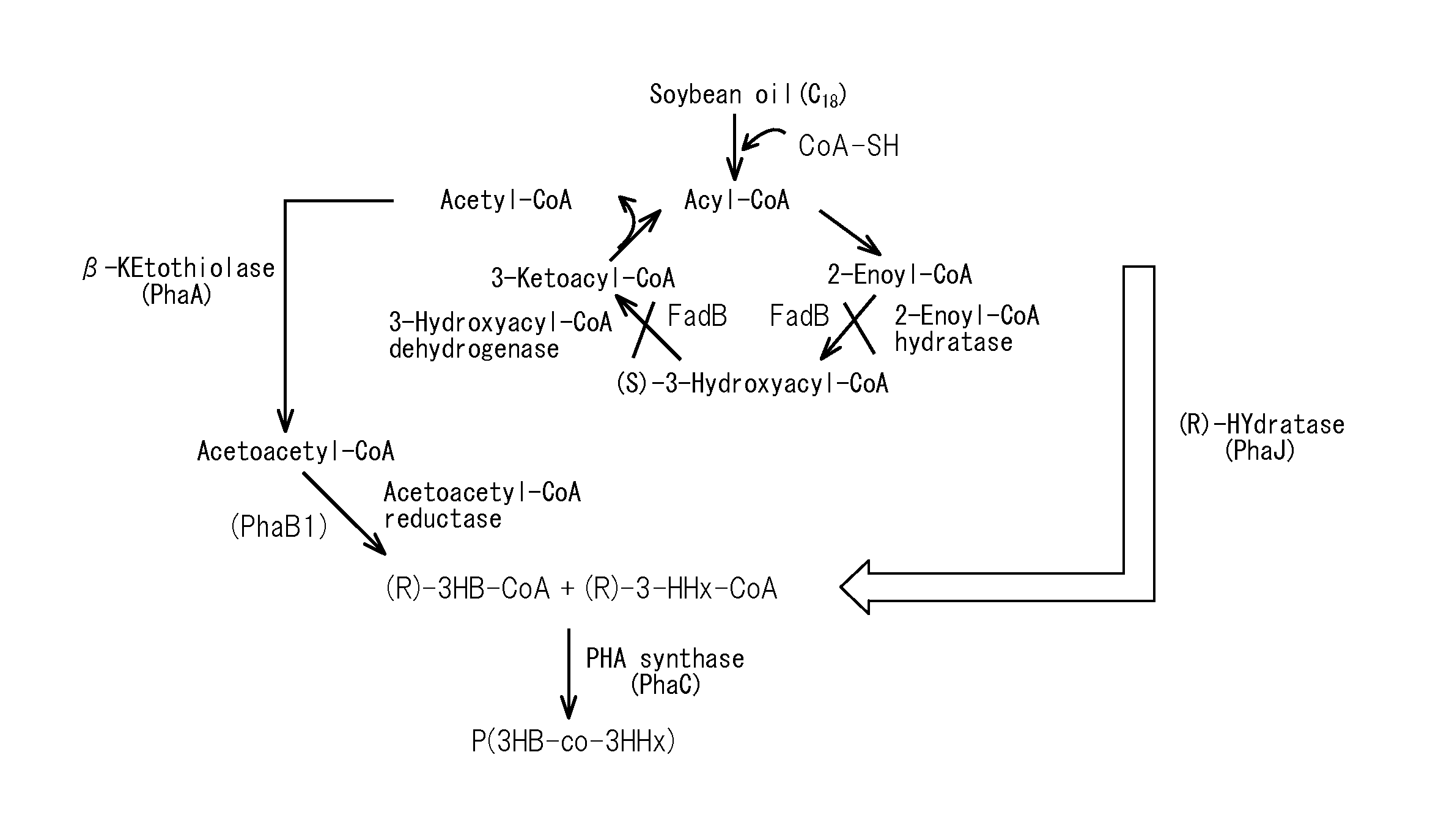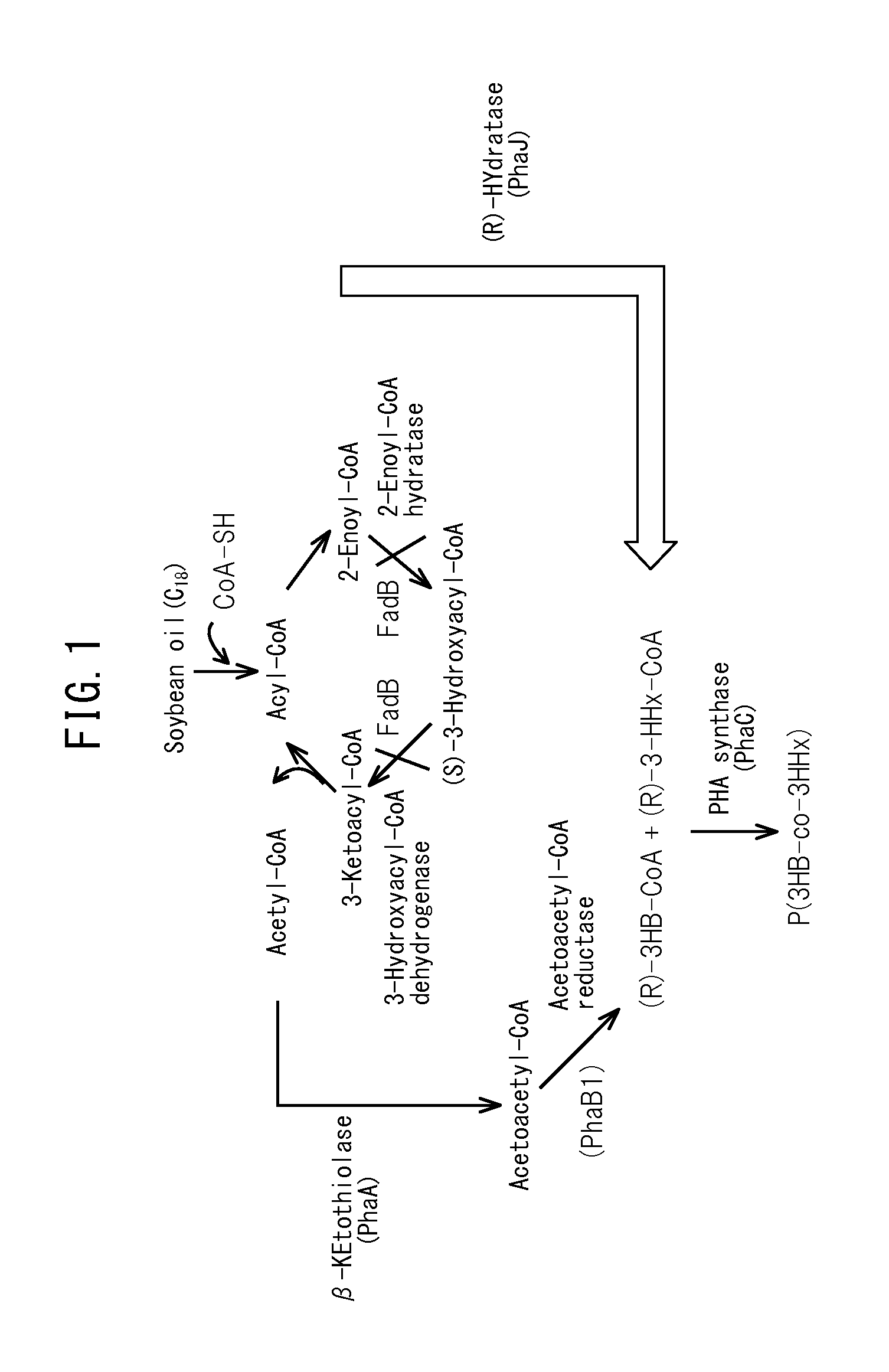Production method for copolymer polyhydroxyalkanoate using genetically modified strain of fatty acid ß-oxidation pathway
a technology of ß-oxidation pathway and copolymer polyhydroxyalkanoate, which is applied in the direction of lyase, carbon-oxygen lyase, enzymology, etc., can solve the problems of difficult practical use of p(3hb), low intracellular content of about 15%, and difficult disposal of p(3hb), etc., to achieve high pha production ability, high 3hhx fraction, and high proliferation ability
- Summary
- Abstract
- Description
- Claims
- Application Information
AI Technical Summary
Benefits of technology
Problems solved by technology
Method used
Image
Examples
example 1
Recombinant Cupriavidus necator Strains Used
[0056]In the following example, recombinant strains of Cupriavidus necator imparted with the ability to produce poly(3-hydroxybutyrate-co-3-hydroxyhexanoate) in the form of a NSDG strain, a NSDGΔA strain, a MF01 strain, a MF03 strain and a MF03-J1 strain were used as hosts for genetic recombination. “NSDG strain” is a transformant in which a PHA synthase mutant enzyme gene in the form of phaCNSDG has been introduced into a chromosome of a type of hydrogen bacterium Cupriavidus necator in the form of strain H16, and “NSDGΔA strain” is a transformant in which a β-ketothiolase gene in the form of phaACn has been deleted in the aforementioned strain NSDG. On the other hand, “MF01 strain” is a transformant in which phaACn of the aforementioned strain NSDG has been substituted with a broadly substrate-specific β-ketothiolase gene in the form of bktBCn, “MF03 strain” is a transformant in which phaACn of the aforementioned strain NSDG has been sub...
example 2
FadB Gene in Cupriavidus necator Strain H16
[0057]Genes encoding a bifunctional enzyme that catalyzes the hydration reaction of 2-enoyl-CoA and the dehydrogenation reaction of (S)-3-hydroxyacyl-CoA in the form of FadB were targeted for disruption. FadB genes were identified in chromosomes of Cupriavidus necator as H16_A1526 (485753-488176 of chromosome 1 (NC—008313): SEQ ID NO: 1) (also referred to as “fadB1” in the present description), H16_B0724 (817223-819301 of chromosome 2 (NC—008314): SEQ ID NO: 2) (also referred to as “fadB2” in the present description) and H16_A0461 (485753-488176 of chromosome 1 (NC—008313): SEQ ID NO: 3) (also referred to as “fadB′” in the present description) (see FIG. 2).
example 3
Production of Vectors for Disruption of fadB1
[0058]Gene fadB1 encoding FadB (SEQ ID NO: 1) and approximately 1 kbp regions upstream and downstream therefrom were amplified by PCR using genomic DNA of Cupriavidus necator strain H16 (NC—008313) as template and using the oligonucleotides of Sequence 1 and Sequence 2 indicated below as primers. PCR was carried out for 30 cycles consisting of reacting for 20 seconds at 98° C., 15 seconds at 65° C. and 3 minutes at 68° C. using KOD Plus (Toyobo Co., Ltd.). The amplified fragment was purified with a DNA purification kit (Promega Corp.).
Sequence 1:CCCAAGCTTTCAGCGCGAACCAGTACTCGGC(SEQ ID NO: 4)(Underline indicates HindIII restrictase site)Sequence 2:TGCTCTAGAGACGAGCAGAAGCGGTTGACG(SEQ ID NO: 5)(Underline indicates XbaI restrictase site)
[0059]Subsequently, the 5′-terminal was phosphorylated by T4 kinase (Toyobo Co., Ltd.), and ligated with pUC118 (Takara Bio Inc.), subjected to HincII cleavage and alkaline phosphatase treatment, with Ligation H...
PUM
| Property | Measurement | Unit |
|---|---|---|
| temperature | aaaaa | aaaaa |
| thickness | aaaaa | aaaaa |
| inner diameter | aaaaa | aaaaa |
Abstract
Description
Claims
Application Information
 Login to View More
Login to View More - R&D
- Intellectual Property
- Life Sciences
- Materials
- Tech Scout
- Unparalleled Data Quality
- Higher Quality Content
- 60% Fewer Hallucinations
Browse by: Latest US Patents, China's latest patents, Technical Efficacy Thesaurus, Application Domain, Technology Topic, Popular Technical Reports.
© 2025 PatSnap. All rights reserved.Legal|Privacy policy|Modern Slavery Act Transparency Statement|Sitemap|About US| Contact US: help@patsnap.com



